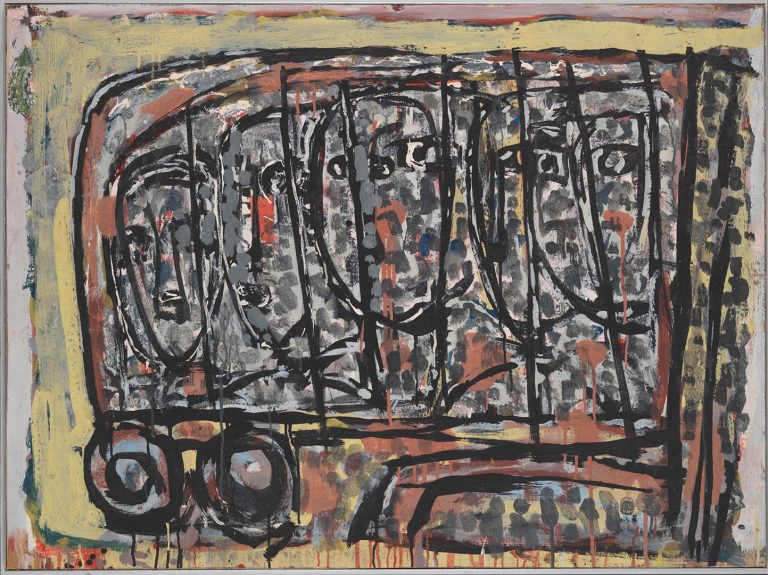We acknowledge the Traditional Owners of the land on which the Queensland Art Gallery | Gallery of Modern Art stands and recognise the creative contribution First Australians make to the art and culture of this country.

Ian Fairweather / Scotland/Australia 1891–1974 / Bus stop 1965 / Gouache on cardboard on board / 72.5 x 97.5cm / Gift of the Josephine Ulrick and Win Schubert Foundation for the Arts through the Queensland Art Gallery Foundation 2012. Donated through the Australian Government’s Cultural Gifts Program / Collection: Queensland Art Gallery | Gallery of Modern Art / © Ian Fairweather 1965/DACS. Licensed by Viscopy
Ian FairweatherBus stop 1965
Not Currently on Display
Bus stop 1965, which Ian Fairweather painted in his studio on Queensland’s Bribie Island, is unique in the artist’s oeuvre because of its quotidian subject matter. In a note dated 15 March 1965, the artist wrote that ‘the bus stop is part of the landscape as seen from the beach outside the grocery — over my daily bottle of milk’.1 Writer Murray Bail described the painting as an ‘exploration of relationships and a comment on an everyday but ritualised event’.2
It is easy to imagine Fairweather drinking his milk, watching people board the bus on their way to work or to the shops, and perhaps considering the contrast between their daily routine and his own. The painting’s subject is reminiscent of other works from the period, such as John Brack’s Collins Street, 5p.m. 1955 (National Gallery of Victoria), which captures the drudgery of the urban commute.
Endnotes:
1. Ian Fairweather, 15 March 1965, in Murray Bail, Fairweather, Philip Bacon Galleries, Brisbane, 1984, p.20.
2. Murray Bail, Fairweather, p.20.
Ian Fairweather was born in Scotland in 1891. His father encouraged him to join the British Army and, in June 1914, just two months after he was commissioned, Fairweather was captured by the German Army and sent to a prison camp. There, he studied Japanese, sketched, and illustrated the prisoners’ magazine. After the war, he studied at the Slade School of Fine Art, London.
Leaving England in 1927, Fairweather travelled continually for nearly two decades, journeying to Canada, China, Indonesia, South America, the Philippines, Japan and Australia. In 1952, he attempted to cross the sea from Darwin to Timor on a raft, which turned into a perilous, 16-day solo journey that ended in Roti, Indonesia, from where he was deported to England.
When he returned to Australia in 1953, Fairweather retreated from society. He built a rudimentary hut on Bribie Island, north of Brisbane, and went on to produce his greatest works there until his death in 1974.
Discussion Questions
1. In Fairweather’s painting the passengers are looking out the windows of a bus. Describe the relationship between the audience looking at the painting and the passengers who look out towards the viewer.
2. Why do you think Fairweather painted the people unusually large compared to the bus?
Classroom Activities
Imagine you are one of the passengers on the bus. Which one would you be? Draw or paint a picture what you see out of the window in 1965. Now imagine that you are a passenger on the bus today, and draw or paint that view. Compare drawings. What has changed?